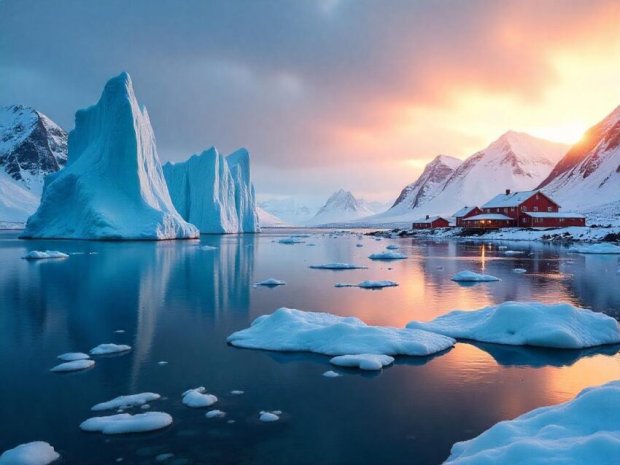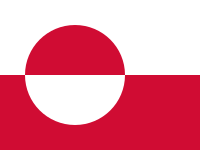How Greenland Emerges as New Arctic Escape for American and Canadian Tourists, Fueling a Surge in Polar Travel, Latest Update You Need To Know

Travel & Tour World
Greenland is no longer a forgotten icy frontier. Instead, Greenland emerges as a new Arctic escape, pulling in curious American and Canadian tourists looking to rewrite the meaning of travel. The world’s largest island is suddenly on the radar—fueling a surge in polar travel that feels fresh, wild, and breathtaking. But why now? And what’s driving this sudden shift?
As Arctic landscapes call louder than ever, American and Canadian tourists are turning away from crowded beach resorts and heading north—toward something raw, remote, and real. Greenland, in its stark and untamed beauty, offers exactly that. Here, silence is powerful. Ice is alive. And culture runs deep.
With rising interest in sustainable adventure, Greenland’s Arctic escape status is becoming irresistible. Direct flights from North America are increasing. Expeditions, glacier treks, and cultural tours are booking out months ahead.
This is not a trend—it’s a travel awakening.
The latest update you need to know? This icy giant is no longer hiding in plain sight. Greenland is stepping forward, bold and luminous, claiming its place as the Arctic escape for a new generation of travelers chasing authenticity.
And it’s only just beginning.
North Americans Are Falling in Love With Greenland—And the Travel Industry Is Paying Attention
A once-remote corner of the world is now finding itself in the spotlight. Greenland, the massive ice-covered island between the North Atlantic and Arctic Oceans, is fast becoming a must-see destination for American and Canadian travelers. With its surreal landscapes, rapidly changing climate, and untouched cultural depth, Greenland is no longer a fringe fantasy—it’s the new frontier of polar adventure.
And the numbers are telling a powerful story.
From Hidden Gem to Travel Boom
Over the last 24 months, Greenland has recorded a significant rise in North American tourism, driven by post-pandemic wanderlust, climate curiosity, and a sharp uptick in interest in “last-chance” destinations. Tourists from New York, Toronto, Vancouver, Seattle, and Boston are leading the way, seeking the untamed beauty that Greenland uniquely offers.
Adventure travelers, nature lovers, photographers, and sustainability-conscious tourists are all converging on this icy gem. As a result, Greenland has moved from bucket-list territory to a serious travel contender—especially during the high season between June and September.
Airline Routes Catch Up to Demand
Airlines are responding. Both regional and long-haul carriers are expanding flight options to Nuuk, Kangerlussuaq, and Ilulissat, Greenland’s most accessible gateways.
Air Greenland has recently increased service capacity from Copenhagen, Reykjavík, and now seasonally from Ottawa and New York, creating more efficient connections for North Americans. Meanwhile, U.S.-based tour operators are building package options that combine Iceland and Greenland for two-in-one Arctic adventures.
These new flight options mean travelers are no longer enduring complex, multi-day transfers just to reach the edge of the ice sheet. Now, Greenland is a short hop away from major North Atlantic hubs.
Hotels and Local Infrastructure Evolve Quickly
The growth in tourist demand is pushing local infrastructure to scale, without sacrificing sustainability. Greenland’s hotel scene is expanding with new eco-lodges, updated guesthouses, and more premium wilderness camps opening along the fjords.
Cities like Ilulissat—home to the UNESCO-listed Icefjord—are seeing hotel renovations and new boutique properties that reflect both modern comfort and Greenlandic identity. Operators are also increasing investment in community-based tourism, allowing visitors to immerse themselves in authentic local culture while directly supporting Greenlandic livelihoods.
Meanwhile, cruise lines are scheduling more Arctic expedition itineraries that begin or end in Greenland ports, adding to the exposure and economic benefit.
Why Now? A Race Against Time—and Ice
The emotional draw of Greenland lies in its urgency. Climate change is transforming its glaciers, ice caps, and ecosystems before the world’s eyes. Tourists want to witness the spectacle—before it changes forever.
Glacier hiking, iceberg kayaking, dog sledding, and Northern Lights viewing are no longer extreme activities. They’re high-priority goals for travelers who feel that ticking clock. The blend of ecological awareness and emotional adventure is creating deep demand for Greenland’s once-isolated experiences.
Tourism Meets Preservation
But Greenland’s government and tourism authorities are walking a tightrope. They want to harness the financial power of tourism while preserving what makes the island so special: its remoteness, its silence, its wildness.
Visitor caps on certain routes, strict sustainability certifications, and community-first policies are already in place. There’s a clear message—Greenland will grow, but not at the cost of its natural or cultural identity.
For American and Canadian tourists, this approach adds emotional value. They’re not just visiting a destination—they’re contributing to its preservation.
The Arctic Is Hot—and Not Just Literally
The Arctic travel trend is exploding. Alongside Greenland, destinations like Svalbard, Iceland, and the Canadian Arctic are all seeing growth in demand. But Greenland stands out because of its sheer scale, purity, and the depth of its Inuit culture.
It feels untouched. It feels real. And in an age of overtourism, that kind of authenticity is priceless.
Social media is amplifying the allure. Drone footage of glacier cliffs, shots of humpback whales in sapphire bays, and clips of hikers gazing at endless white landscapes are driving a surge in travel interest, especially among younger Americans and Canadians.
Tourism Authorities Watch the Shift Closely
Tourism boards in the US, Canada, and Nordic countries are taking note of this redirection in travel preferences. They’re seeing more interest in nature-driven itineraries, slow travel, and low-footprint destinations. Greenland is now being positioned not as a hard-to-reach extreme, but as a transformational experience that checks all the right boxes: authenticity, sustainability, emotion, and education.
Expect to see more joint campaigns, partnerships, and polar travel expos geared toward North American audiences through 2026 and beyond.
A Gateway to the Future of Travel
Greenland’s emergence is more than a passing trend. It represents a fundamental shift in how travelers think, feel, and choose their destinations. In an age dominated by screens, stress, and saturation, Greenland offers a reset—a way to reconnect with Earth, with silence, with scale.
For Americans and Canadians, it’s no longer a journey into the unknown. It’s a conscious return to what travel was meant to be: thrilling, humbling, and unforgettable.
Conclusion: The Ice Beckons—Are You Ready to Answer?
Greenland is writing a new chapter in global tourism. And North Americans are turning its pages faster than ever.
With expanded flight routes, enhanced infrastructure, and growing emotional urgency, the island is carving its place among the world’s most sought-after travel experiences. Airlines, tour operators, and local communities are adapting fast—but doing it right.
For travelers who want more than just a vacation, who seek meaning, scale, and beauty, Greenland has become the Arctic dream within reach.
Welcome to Greenland – The World’s Wildest Escape
Imagine a place where silence roars louder than sound, where icebergs float like drifting cathedrals, and where the land seems to breathe in slow, ancient rhythms. That place is Greenland—the world’s largest island and one of the last true frontiers for travelers seeking meaning, wonder, and wildness.
This isn’t your typical vacation spot. Greenland isn’t made for lounging. It’s made for living—fully, deeply, and consciously.
Whether you’re drawn by the magic of the Northern Lights, the thunder of calving glaciers, or the quiet resilience of Inuit culture, Greenland delivers an experience you’ll never shake from memory.
Here’s everything you need to know to explore this magnificent destination.
Getting There: A Journey into the Edge of the World
Despite its remote location, Greenland is becoming more accessible. Most travelers fly in via Copenhagen or Reykjavík, connecting to Nuuk, Kangerlussuaq, or Ilulissat—the main entry points into this vast Arctic land.
Seasonal direct flights from North America, particularly New York and Ottawa, are expanding options for adventurous travelers.
Pro tip: Book early. Greenland’s air traffic is limited and demand is growing fast.
When to Visit: Choose Your Greenland
- Summer (June–August) brings long daylight hours, hiking, boat tours, and whale watching.
- Autumn (September–October) offers crisp air, fewer tourists, and a better chance of seeing the Northern Lights.
- Winter (November–March) transforms the landscape into a frozen dream. Think dog sledding, snowshoeing, and mind-blowing aurora displays.
- Spring (April–May) is shoulder season, offering a balance of snow activities and emerging daylight.
Each season offers a different Greenland. Choose the one that speaks to your soul.
Top Places to Explore
1. Ilulissat – Home of Ice and Awe
This UNESCO World Heritage town sits next to the Ilulissat Icefjord, a corridor of floating ice that leaves even seasoned travelers speechless. Boat tours weave through massive bergs. Hikes lead to glacier viewpoints. Photographers, this is your dreamscape.
2. Nuuk – The Cultural Heartbeat
Greenland’s capital is compact but vibrant. Visit the National Museum, stroll the colorful harbor, and eat at local restaurants serving reindeer stew or Arctic char. Nuuk blends modern life with Indigenous spirit in every street corner.
3. Kangerlussuaq – Gateway to the Ice Sheet
This small town offers direct access to the Greenland Ice Sheet, one of the few places on Earth where you can literally walk on an ancient glacier. Wildlife sightings are common—musk oxen, Arctic foxes, and more.
4. Qaqortoq – Southern Serenity
In the south, Qaqortoq feels like a secret. Surrounded by green hills in summer, this town charms with art installations, hot springs, and hiking trails that wind through Norse ruins.
5. East Greenland – Remote and Raw
For truly off-the-grid adventure, head east. Tasiilaq and Ittoqqortoormiit are isolated, awe-inspiring, and unforgettable. Here, you’ll find towering peaks, deep fjords, and communities where tradition still shapes daily life.
What to Do: Adventures That Stir the Spirit
- Icefjord Cruising – Glide through floating ice in midnight sun or golden hour.
- Glacier Hiking – Strap on crampons and walk across ancient ice.
- Dog Sledding – Led by seasoned mushers, this traditional mode of transport becomes a thrill ride across the snow.
- Kayaking – Paddle quietly near whales, seals, and drifting icebergs.
- Aurora Chasing – Lie under star-speckled skies as the Northern Lights ripple above.
- Inuit Cultural Encounters – Learn the deep-rooted traditions that sustain Greenland’s Indigenous communities.
Where to Stay: Lodges with a View—and a Soul
Greenland doesn’t do mega-resorts. Accommodations range from boutique hotels to eco-lodges, all offering breathtaking views and warm hospitality.
- Hotel Arctic (Ilulissat) – Overlooks the Icefjord. Luxury meets edge-of-the-world magic.
- Inuk Hostels (Nuuk) – Community-run, sustainable, and friendly.
- Camp Kiattua (near Nuuk) – A remote wilderness camp offering comfort, firelight, and fjord serenity.
More places are popping up each year, but everything remains intentionally small-scale—respectful of the land, people, and resources.
What to Know Before You Go
- Currency: Danish Krone (DKK)
- Language: Greenlandic (Kalaallisut) and Danish. English widely spoken in tourism areas.
- Connectivity: Limited. Wi-Fi exists but is often slow and pricey. Unplug and embrace the silence.
- Weather: Unpredictable. Pack layers, waterproof gear, and insulated boots. Always.
- Culture: Respect is everything. Listen more than you speak. Learn the land’s rhythm.
- Travel Insurance: Essential. Delays, weather changes, and cancellations are common.
Why Greenland? Because the World Is Still Wild
Greenland isn’t just a place. It’s a feeling. It’s the echo of glaciers cracking. The silence of a fjord. The stillness of snow that seems alive. It’s a reconnection—not just with nature, but with something deeper inside yourself.
In a world overrun by noise, distraction, and copy-paste travel experiences, Greenland remains real. Rugged. Quiet. Raw.
It’s not easy. It’s not cheap. And that’s why it matters. Because sometimes, the most unforgettable journeys are the ones that ask more from you—and give even more in return.


